For the first time, astronomers have linked a mysterious fast radio burst with gravitational waves
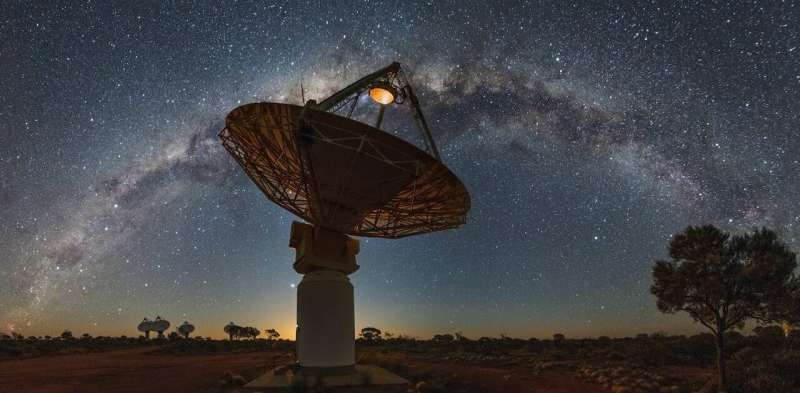
We have just published evidence in Nature Astronomy for what might be producing mysterious bursts of radio waves coming from distant galaxies, known as fast radio bursts or FRBs.
Two colliding neutron stars—each the super-dense core of an exploded star—produced a burst of gravitational waves when they merged into a "supramassive" neutron star. We found that two and a half hours later they produced an FRB when the neutron star collapsed into a black hole.
Or so we think. The key piece of evidence that would confirm or refute our theory—an optical or gamma-ray flash coming from the direction of the fast radio burst—vanished almost four years ago. In a few months, we might get another chance to find out if we are correct.
Brief and powerful
FRBs are incredibly powerful pulses of radio waves from space lasting about a thousandth of a second. Using data from a radio telescope in Australia, the Australian Square Kilometer Array Pathfinder (ASKAP), astronomers have found that most FRBs come from galaxies so distant, light takes billions of years to reach us. But what produces these radio wave bursts has been puzzling astronomers since an initial detection in 2007.
The best clue comes from an object in our galaxy known as SGR 1935+2154. It's a magnetar, which is a neutron star with magnetic fields about a trillion times stronger than a fridge magnet. On April 28 2020, it produced a violent burst of radio waves—similar to an FRB, although less powerful.
Astronomers have long predicted that two neutron stars—a binary—merging to produce a black hole should also produce a burst of radio waves. The two neutron stars will be highly magnetic, and black holes cannot have magnetic fields. The idea is the sudden vanishing of magnetic fields when the neutron stars merge and collapse to a black hole produces a fast radio burst. Changing magnetic fields produce electric fields—it's how most power stations produce electricity. And the huge change in magnetic fields at the time of collapse could produce the intense electromagnetic fields of an FRB.
The search for the smoking gun
To test this idea, Alexandra Moroianu, a masters student at the University of Western Australia, looked for merging neutron stars detected by the Laser Interferometer Gravitational-Wave Observatory (LIGO) in the US. The gravitational waves LIGO searches for are ripples in spacetime, produced by the collisions of two massive objects, such as neutron stars.

LIGO has found two binary neutron star mergers. Crucially, the second, known as GW190425, occurred when a new FRB-hunting telescope called CHIME was also operational. However, being new, it took CHIME two years to release its first batch of data. When it did so, Moroianu quickly identified a fast radio burst called FRB 20190425A which occurred only two and a half hours after GW190425.
Exciting as this was, there was a problem—only one of LIGO's two detectors was working at the time, making it very uncertain where exactly GW190425 had come from. In fact, there was a 5% chance this could just be a coincidence.
Worse, the Fermi satellite, which could have detected gamma rays from the merger—the "smoking gun" confirming the origin of GW190425—was blocked by Earth at the time.
Unlikely to be a coincidence
However, the critical clue was that FRBs trace the total amount of gas they have passed through. We know this because high-frequency radio waves travel faster through the gas than low-frequency waves, so the time difference between them tells us the amount of gas.
Because we know the average gas density of the universe, we can relate this gas content to distance, which is known as the Macquart relation. And the distance traveled by FRB 20190425A was a near-perfect match for the distance to GW190425. Bingo!
So have we discovered the source of all FRBs? No. There are not enough merging neutron stars in the Universe to explain the number of FRBs—some must still come from magnetars, like SGR 1935+2154 did.
And even with all the evidence, there's still a one in 200 chance this could all be a giant coincidence. However, LIGO and two other gravitational wave detectors, Virgo and KAGRA, will turn back on in May this year, and be more sensitive than ever, while CHIME and other radio telescopes are ready to immediately detect any FRBs from neutron star mergers.
In a few months, we may find out if we've made a key breakthrough—or if it was just a flash in the pan.
More information: Alexandra Moroianu et al, An assessment of the association between a fast radio burst and binary neutron star merger, Nature Astronomy (2023). DOI: 10.1038/s41550-023-01917-x
Journal information: Nature Astronomy
Provided by The Conversation
This article is republished from The Conversation under a Creative Commons license. Read the original article.![]()
Deciphering the lives of double neutron stars in radio and gravitational wave astronomy
Uncanny Coincidence: Fast Radio Burst Detected After Gravitational Wave Event
Every so often, a strange signal from outer space hits our detectors here on Earth.
Known as fast radio bursts (FRBs), these signals are extremely short, just milliseconds in duration, and are detected only in radio wavelengths.
Yet in those milliseconds, and in those wavelengths, they can discharge as much energy as 500 million Suns – and most of them have never been detected again.
What they are, and how they are generated, is something of a baffling mystery. But a new discovery could point to a previously unknown mechanism producing these powerful bursts of radiation.
On the 25th of April in 2019, the Canadian Hydrogen Intensity Mapping Experiment (CHIME) recorded a bright, non-repeating fast radio burst ( FRB).
Just 2.5 hours earlier, the Laser Interferometer Gravitational-Wave Observatory (LIGO) recorded a gravitational wave event, the collision as a binary neutron star reached the inevitable conclusion of its decaying orbit.
The FRB's location in the sky fell within the credible region of the gravitational wave event, and from a similar distance. The chance that the two events were unrelated, a team of astronomers led by Alexandra Moroianu of the University of Western Australia has determined, is extremely small.
FRBs are extremely enigmatic; only a few of them repeat, and the one-off nature of the vast majority makes them extraordinarily difficult to study.
Their detection used to be chance only; you had to be studying the right patch of the sky at the right time to catch one. All-sky surveys, however, have increased the number of detections to over 600.
A breakthrough came in 2020: for the first time, an FRB was detected coming from within the Milky Way galaxy. It was traced to a type of neutron star called a magnetar, whose insanely powerful external magnetic field fights against the inward pull of gravity, causing the star to occasionally quake and flare.
But while misbehaving magnetars present one explanation, we don't know if that's the whole picture. FRBs vary quite a bit, and it's likely that there's more than one mechanism that can produce them.
There are several theories that predict an association between FRBs and gravitational waves, particularly if neutron stars are involved, either during or following the gravitational wave detection.
So Moroianu and her colleagues went looking in catalogs. The CHIME catalog of observations from July 2018 to July 2019 overlapped with the LIGO-Virgo observation run, for a total of 171 FRB events.
The researchers cross-referenced these events with the GWTC-2 catalog, looking for FRB events that occurred temporally close to gravitational wave detections, within the patch of the sky identified by LIGO.
And they got a very palpable hit.
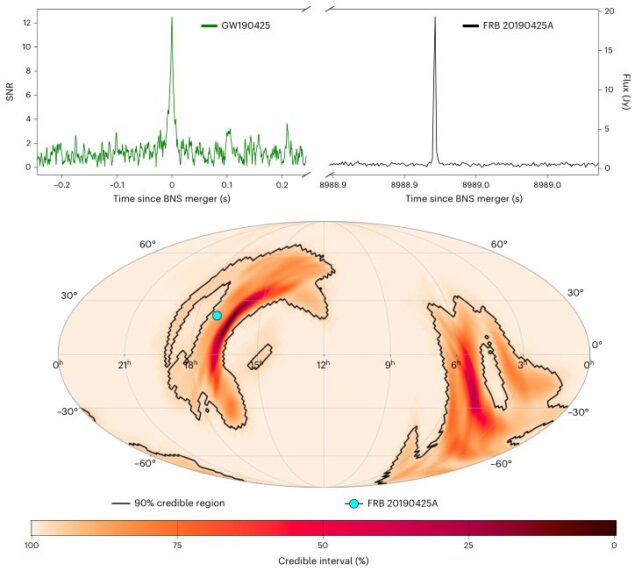
GW20190425 was observed by LIGO on 25 April 2019 at 08:18:05 UTC. The absence of a detection by the Virgo detector helped constrain the region from which the detection had emerged. Its estimated distance was around 520 million light-years away, generated by a merger between two neutron stars.
FRB20190425A was detected the same day, at 10:46:33 UTC, within the range of sky LIGO had laid out as a plausible source of the neutron star merger, and with an upper distance limit of 590 million light-years.
This, they found, would be an uncanny coincidence if the two were unrelated. The probability of the two events occurring at the distances given, the timeframe of detection, and within the region of space defined by LIGO was just 0.00019, the researchers calculated.
The two events likely emerged from a galaxy called UGC 10667, but the mechanism that produced the FRB might take a little more analysis.
For now, the team believes that the burst was caused by a blitzar, a mechanism proposed for FRBs nearly a decade ago. This is when a neutron star too massive to remain supported by degeneracy pressure collapses into a black hole when its spin slows – the only thing that was preventing this collapse.
"Although we cannot definitively assign the potential GW-FRB association to a single theory, it is consistent with the GW, short gamma-ray burst (sGRB) and FRB association theory that invokes the collapse of a post-binary neutron star-merger magnetar," the researchers write.
"The FRB generation mechanism is the so-called blitzar mechanism, which has been confirmed through numerical simulations. Within this scenario, the 2.5-hour delay time between the FRB and the GW event is the survival time of the supramassive neutron star before collapsing into a black hole, which is consistent with the expected range of the delay timescale for a supramassive magnetar from both theory and observational data."
The masses of the neutron stars of GW20190425 were significantly higher than most neutron star binaries detected in the Milky Way. These lower mass binaries would produce more stable heavyweight neutron stars after they merge, which could survive a long time and repeatedly spit out FRBs, thus explaining the few repeating FRB sources.
Whether or not the two events were linked remains to be confirmed, but one thing is certain: the estimated rate of binary neutron star mergers is far, far lower than the rate at which FRBs like FRB190425A are detected. So this potential mechanism cannot, alone, account for the mysterious signals that sputter across the radio sky.
Further investigation is still warranted. But it's tremendously exciting that we seem to be closing in on some answers.
The research has been published in Nature Astronomy.
Watch a gamma-ray burst in this stunning animation
Brightest gamma-ray burst ever seen a 1-in-10,000-years event that's 'absolutely monstrous,' scientists say
By Mike Wall published 4 days ago
'There's a reasonable chance this is the brightest gamma-ray burst to hit Earth since human civilization began.'

The Hubble Space Telescope’s Wide Field Camera 3 revealed the infrared afterglow (circled) of the BOAT GRB and its host galaxy, seen nearly edge-on as a sliver of light extending to the burst's upper right. This composite incorporates images taken on Nov. 8 and Dec. 4, 2022, one and two months after the eruption.
An extragalactic outburst whose light hurtled through the inner solar system last fall was 70 times brighter than any other such eruption that scientists have observed, researchers report.
Radiation from the explosion — a gamma-ray burst (GRB) known as GRB 221009A — swept over Earth on Oct. 9, 2022. It saturated gamma-ray detectors on multiple space telescopes, earning the nickname the BOAT, short for "brightest of all time."
Astronomers continued studying the BOAT with a variety of instruments for several months afterward, seeking to characterize the explosion further. And those efforts have only added to the BOAT's legend.
"It is just an absolutely monstrous burst. It is extremely extraordinary; we've never seen anything remotely close to it," Eric Burns, an assistant professor of physics and astronomy at Louisiana State University, said Tuesday (March 28) during a press conference at the 20th meeting of the American Astronomical Society's High Energy Astrophysics Division in Hawaii.
"The BOAT is a once-in-10,000-year event," Burns added. "So, there's a reasonable chance this is the brightest gamma-ray burst to hit Earth since human civilization began."
Related: What is a gamma-ray burst?
The brightest explosion of all time
It is just an absolutely monstrous burst."Eric Burns, astronomer at LSU
GRBs are the most powerful explosions in the universe. They generate more energy in mere seconds than Earth's sun will produce over its entire 10-billion-year lifetime.
Astronomers recognize two different classes: short GRBs, which last about two seconds or less, and long ones, which can continue for multiple minutes. The short variety is likely spawned by collisions of superdense stellar corpses known as neutron stars, astronomers say. Most long GRBs, on the other hand, are generated by black holes born as massive stars collapse and die.
"So, you have the core collapse; this creates a black hole. The black hole powers jets that propagate out at just under the speed of light," Burns said.
"As these jets go out, they release their energy in the form of prompt gamma-ray burst emission," he added. "This is followed by what's known as afterglow, and at later times, the energy deposited into that star powers a supernova explosion."
The BOAT was a long GRB, so researchers expect a supernova to emerge at its locale, a spot about 1.9 billion light-years from Earth. But they haven't found one yet, despite searching the area with NASA's James Webb Space Telescope and Hubble Space Telescope, along with other instruments.
"If it's there, it's very faint," Andrew Levan, a professor of astrophysics at Radboud University in the Netherlands, said in a NASA statement on Tuesday(opens in new tab). "We plan to keep looking, but it's possible the entire star collapsed straight into the black hole instead of exploding."
Why so bright?
GRB jets tend to be relatively narrow, so most of them don't sweep over Earth. But these astrophysical events, though extreme, are common enough to be observed in bulk. Astronomers have catalogued about 12,000 GRBs to date using data gathered by tools such as NASA's Fermi Gamma-ray Space Telescope and Konus, a Russian instrument that flies on NASA's Wind spacecraft, Burns said.
He led an analysis that dug deep into the GRB record, establishing the BOAT's brightness bona fides. And other work showed that this superlative brightness didn't stem from overly powerful jets.
"When you compare the energy in this jet, it's very similar to the energy of jets we've seen in other GRBs," Kate Alexander, an assistant professor of astronomy at the University of Arizona, said during Tuesday's press conference.
"So then, why was it so bright?" she added. "It turns out that all of the energy in this jet was focused into a very narrow angle. So, all of the particles moving in this jet were very, extremely narrowly beamed, and that narrow beam happened to be focused right at Earth."
She compared the effect to a garden hose, with the BOAT's jet analogous to the more-intense spray you get by using a constricting nozzle.
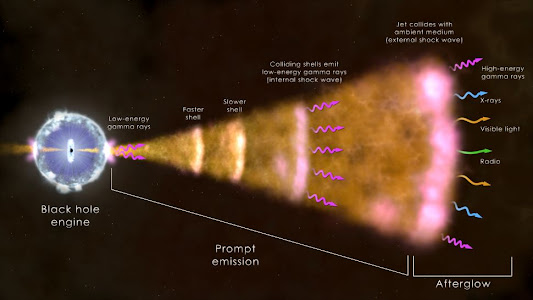
This illustration shows the ingredients of a long gamma-ray burst, the most common type. The core of a massive star (left) has collapsed, forming a black hole that sends a jet of particles moving through the collapsing star and out into space at nearly the speed of light. Radiation across the spectrum arises from hot ionized gas (plasma) in the vicinity of the newborn black hole, collisions among shells of fast-moving gas within the jet (internal shock waves), and from the leading edge of the jet as it sweeps up and interacts with its surroundings (external shock).
RELATED STORIES:
— Brightest gamma-ray burst ever seen could help reveal how black holes are born
— 'Castaway' gamma-ray bursts come from distant early galaxies
— Weird nearby gamma-ray burst defies expectations
Astronomers had to put some of their BOAT observations on hold a few months ago, as the source region went behind the sun from Earth's perspective. But that area is now coming back into view, and researchers are ready.
"More observations, including with Hubble and with Webb, are going to be undertaken in the next few weeks and months," Levan said during the Tuesday telecon.
He and a number of other researchers are especially keen to determine whether or not the BOAT spawned a supernova.
"Watch this space for what we hope will be a more conclusive answer!" Levan said.
Researchers reported these and other BOAT results in a special issue of The Astrophysical Journal Letters
Mike Wall is the author of "Out There(opens in new tab)" (Grand Central Publishing, 2018; illustrated by Karl Tate), a book about the search for alien life. Follow him on Twitter @michaeldwall(opens in new tab). Follow us on Twitter @Spacedotcom(opens in new tab) or on Facebook(opens in new tab).
Solar System Hit by Pulse of Intense Radiation – Incredible 1-in-10,000-Year Gamma-Ray Burst
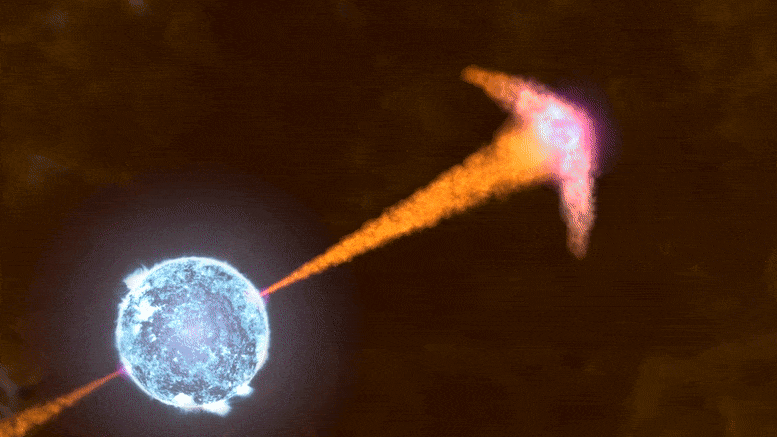
Gamma-ray bursts are the most luminous explosions in the cosmos. Astronomers think most occur when the core of a massive star runs out of nuclear fuel, collapses under its own weight, and forms a black hole, as illustrated in this animation. The black hole then drives jets of particles that drill all the way through the collapsing star at nearly the speed of light. These jets pierce through the star, emitting X-rays and gamma rays (magenta) as they stream into space. They then plow into material surrounding the doomed star and produce a multiwavelength afterglow that gradually fades away. The closer to head-on we view one of these jets, the brighter it appears. Credit: NASA’s Goddard Space Flight Center
On Sunday, October 9, 2022, a pulse of intense radiation swept through the solar system so exceptional that astronomers quickly dubbed it the BOAT – the brightest of all time.
The source was a gamma-ray burst (GRB), the most powerful class of explosions in the universe.
The burst triggered detectors on numerous spacecraft, and observatories around the globe followed up. After combing through all of this data, astronomers can now characterize just how bright it was and better understand its scientific impact.

The Hubble Space Telescope’s Wide Field Camera 3 revealed the infrared afterglow (circled) of the BOAT GRB and its host galaxy, seen nearly edge-on as a sliver of light extending to the burst’s upper right. This composite incorporates images taken on Nov. 8 and Dec. 4, 2022, one and two months after the eruption. Given its brightness, the burst’s afterglow may remain detectable by telescopes for several years. The picture combines three near-infrared images taken each day at wavelengths from 1 to 1.5 microns. Credit: NASA, ESA, CSA, STScI, A. Levan (Radboud University); Image Processing: Gladys Kober
“GRB 221009A was likely the brightest burst at X-ray and gamma-ray energies to occur since human civilization began,” said Eric Burns, an assistant professor of physics and astronomy at Louisiana State University in Baton Rouge. He led an analysis of some 7,000 GRBs – mostly detected by NASA’s Fermi Gamma-ray Space Telescope and the Russian Konus instrument on NASA’s Wind spacecraft – to establish how frequently events this bright may occur. Their answer: once in every 10,000 years.
The burst was so bright it effectively blinded most gamma-ray instruments in space, which means they could not directly record the real intensity of the emission. U.S. scientists were able to reconstruct this information from the Fermi data. They then compared the results with those from the Russian team working on Konus data and Chinese teams analyzing observations from the GECAM-C detector on their SATech-01 satellite and instruments on their Insight-HXMT observatory. Together, they prove the burst was 70 times brighter than any yet seen.
Gamma-ray bursts are the most luminous explosions in the cosmos. Astronomers think most occur when the core of a massive star runs out of nuclear fuel, collapses under its own weight, and forms a black hole, as illustrated in this animation. The black hole then drives jets of particles that drill all the way through the collapsing star at nearly the speed of light. These jets pierce through the star, emitting X-rays and gamma rays (magenta) as they stream into space. They then plow into material surrounding the doomed star and produce a multiwavelength afterglow that gradually fades away. The closer to head-on we view one of these jets, the brighter it appears. Credit: NASA’s Goddard Space Flight Center
Burns and other scientists presented new findings about the BOAT at the High Energy Astrophysics Division meeting of the American Astronomical Society in Waikoloa, Hawaii. Observations of the burst span the spectrum, from radio waves to gamma rays, and include data from many NASA and partner missions, including the NICER X-ray telescope on the International Space Station, NASA’s NuSTAR observatory, and even Voyager 1 in interstellar space. Papers describing the results presented appear in a focus issue of The Astrophysical Journal Letters.
The signal from GRB 221009A had been traveling for about 1.9 billion years before it reached Earth, making it among the closest-known “long” GRBs, whose initial, or prompt, emission lasts more than two seconds. Astronomers think these bursts represent the birth cries of black holes formed when the cores of massive stars collapse under their own weight. As it quickly ingests the surrounding matter, the black hole blasts out jets in opposite directions containing particles accelerated to near the speed of light. These jets pierce through the star, emitting X-rays and gamma rays as they stream into space.

This chart compares the BOAT’s prompt emission to that of five previous record-holding long gamma-ray bursts. The BOAT was so bright it effectively blinded most gamma-ray instruments in space, but U.S. scientists were able to reconstruct its true brightness from Fermi data. Credit: NASA’s Goddard Space Flight Center and Adam Goldstein (USRA)
With this type of GRB, astronomers expect to find a brightening supernova a few weeks later, but so far it has proven elusive. One reason is that the GRB appeared in a part of the sky that’s just a few degrees above the plane of our own galaxy, where thick dust clouds can greatly dim incoming light.
“We cannot say conclusively that there is a supernova, which is surprising given the burst’s brightness,” said Andrew Levan, a professor of astrophysics at Radboud University in Nijmegen, Netherlands. Since dust clouds become more transparent at infrared wavelengths, Levan led near- and mid-infrared observations using NASA’s James Webb Space Telescope – its first use for this kind of study – as well as the Hubble Space Telescope to spot the supernova. “If it’s there, it’s very faint. We plan to keep looking,” he added, “but it’s possible the entire star collapsed straight into the black hole instead of exploding.” Additional Webb and Hubble observations are planned over the next few months.
As the jets continue to expand into material surrounding the doomed star, they produce a multiwavelength afterglow that gradually fades away.

This illustration shows the ingredients of a long gamma-ray burst, the most common type. The core of a massive star (left) has collapsed, forming a black hole that sends a jet of particles moving through the collapsing star and out into space at nearly the speed of light. Radiation across the spectrum arises from hot ionized gas (plasma) in the vicinity of the newborn black hole, collisions among shells of fast-moving gas within the jet (internal shock waves), and from the leading edge of the jet as it sweeps up and interacts with its surroundings (external shock). Credit: NASA’s Goddard Space Flight Center
“Being so close and so bright, this burst offered us an unprecedented opportunity to gather observations of the afterglow across the electromagnetic spectrum and to test how well our models reflect what’s really happening in GRB jets,” said Kate Alexander, an assistant professor in the department of astronomy at the University of Arizona in Tucson. “Twenty-five years of afterglow models that have worked very well cannot completely explain this jet,” she said. “In particular, we found a new radio component we don’t fully understand. This may indicate additional structure within the jet or suggest the need to revise our models of how GRB jets interact with their surroundings.”
The jets themselves were not unusually powerful, but they were exceptionally narrow – much like the jet setting of a garden hose – and one was pointed directly at us, Alexander explained. The closer to head-on we view a jet, the brighter it appears. Although the afterglow was unexpectedly dim at radio energies, it’s likely that GRB 221009A will remain detectable for years, providing a novel opportunity to track the full life cycle of a powerful jet.

XMM-Newton images recorded 20 dust rings, 19 of which are shown here in arbitrary colors. This composite merges observations made two and five days after GRB 221009A erupted. Dark stripes indicate gaps between the detectors. A detailed analysis shows that the widest ring visible here, comparable to the apparent size of a full moon, came from dust clouds located about 1,300 light-years away. The innermost ring arose from dust at a distance of 61,000 light-years – on the other side of our galaxy. GRB221009A is only the seventh gamma-ray burst to display X-ray rings, and it triples the number previously seen around one. Credit: ESA/XMM-Newton/M. Rigoselli (INAF
The burst also enabled astronomers to probe distant dust clouds in our own galaxy. As the prompt X-rays traveled toward us, some of them reflected off of dust layers, creating extended “light echoes” of the initial blast in the form of X-ray rings expanding from the burst’s location. The X-ray Telescope on NASA’s Neil Gehrels Swift Observatory discovered the presence of a series of echoes. Detailed follow-up by ESA’s (the European Space Agency’s) XMM-Newton telescope, together with Swift data, revealed these extraordinary rings were produced by 21 distinct dust clouds.
“How dust clouds scatter X-rays depends on their distances, the sizes of the dust grains, and the X-ray energies,” explained Sergio Campana, research director at Brera Observatory and the National Institute for Astrophysics in Merate, Italy. “We were able to use the rings to reconstruct part of the burst’s prompt X-ray emission and to determine where in our galaxy the dust clouds are located.”
GRB 221009A is only the seventh gamma-ray burst to display X-ray rings, and it triples the number previously seen around one. The echoes came from dust located between 700 and 61,000 light-years away. The most distant echoes – clear on the other side of our Milky Way galaxy – were also 4,600 light-years above the galaxy’s central plane, where the solar system resides.
Lastly, the burst offers an opportunity to explore a big cosmic question. “We think of black holes as all-consuming things, but do they also return power back to the universe?” asked Michela Negro, an astrophysicist at the University of Maryland, Baltimore County, and NASA’s Goddard Space Flight Center in Greenbelt.
Her team was able to probe the dust rings with NASA’s Imaging X-ray Polarimetry Explorer to glimpse how the prompt emission was organized, which can give insights into how the jets form. In addition, a small degree of polarization observed in the afterglow phase confirms that we viewed the jet almost directly head-on.
Together with similar measurements now being studied by a team using data from ESA’s INTEGRAL observatory, scientists say it may be possible to prove that the BOAT’s jets were powered by tapping into the energy of a magnetic field amplified by the black hole’s spin. Predictions based on such models have already successfully explained other aspects of this burst.
References:
“Focus on the Ultra-luminous Gamma-Ray Burst GRB 221009A” March 2023, The Astrophysical Journal Letters.
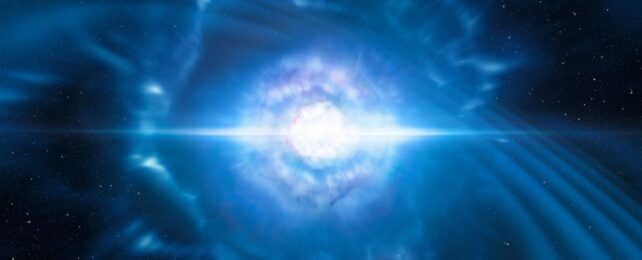 Artist's impression of a neutron star collision.
Artist's impression of a neutron star collision.